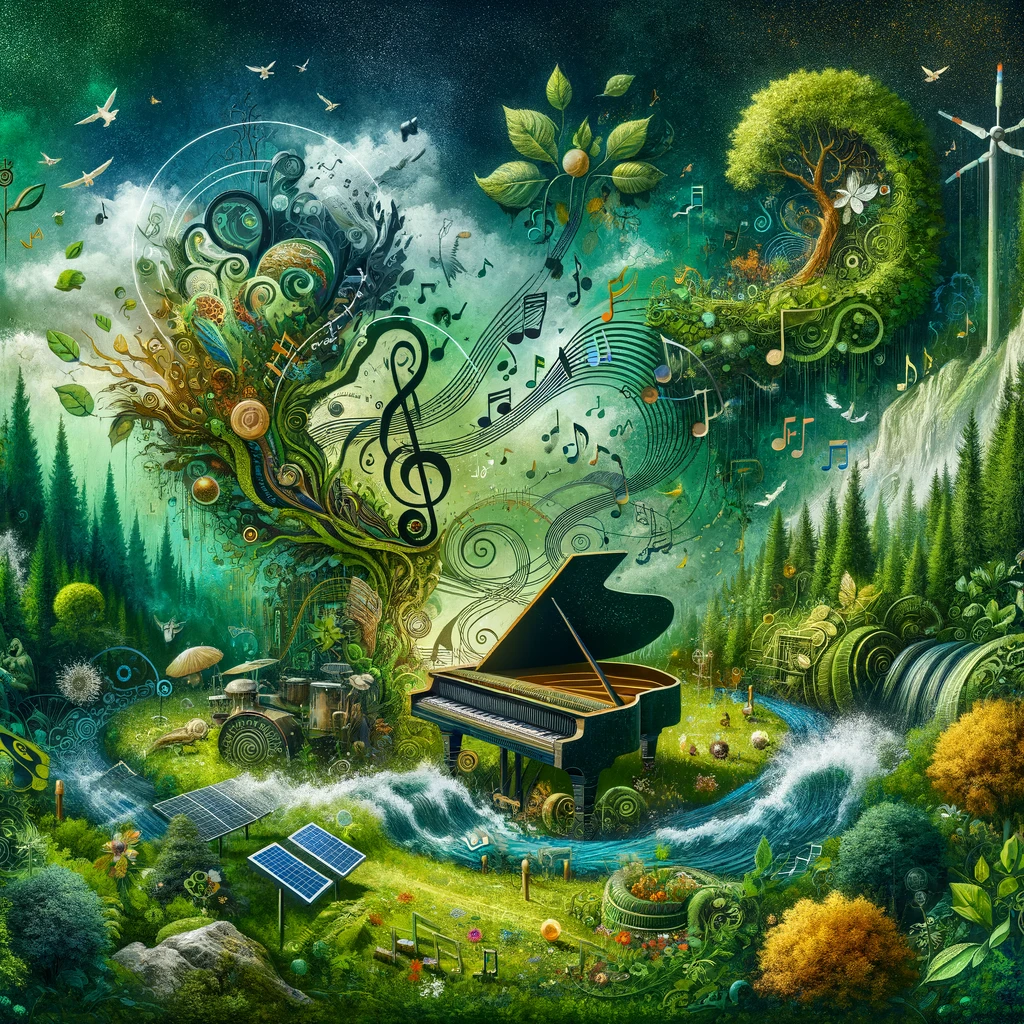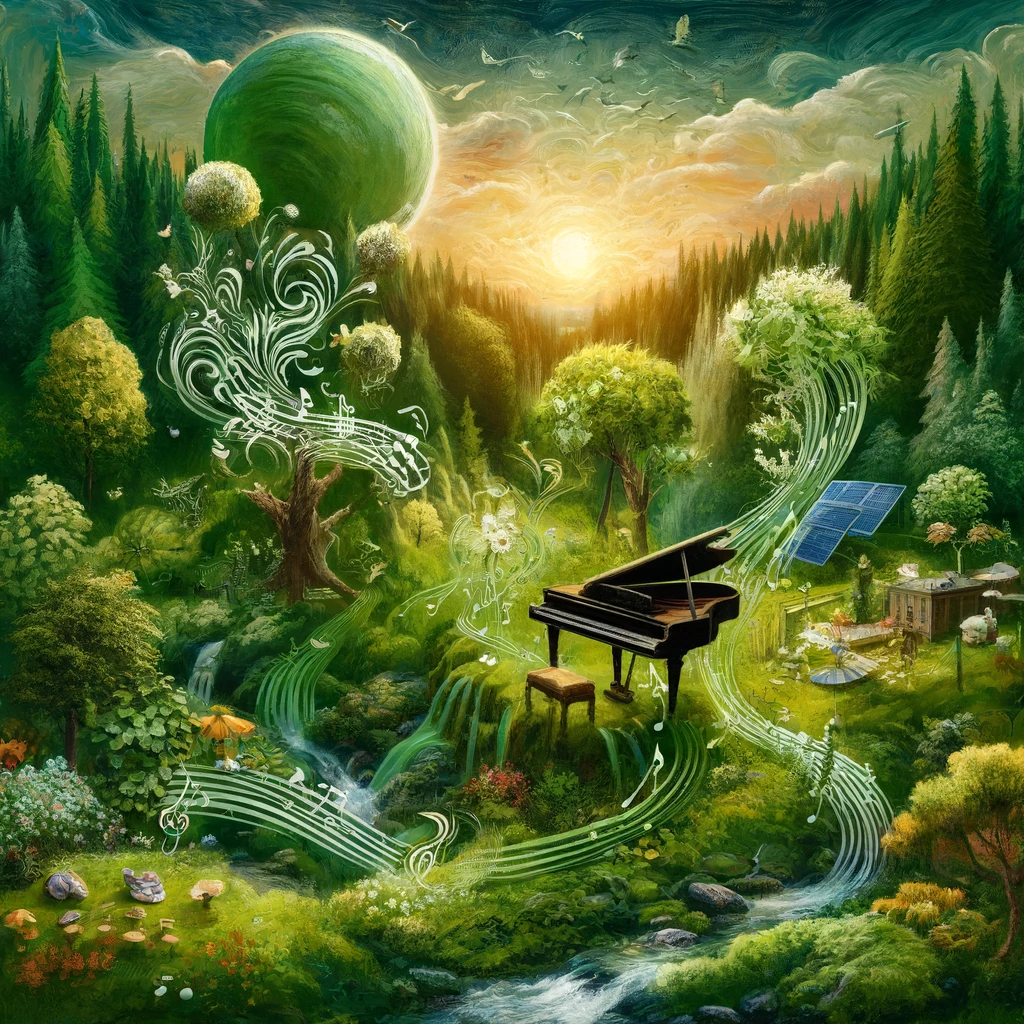
Beethoven’s Eco-Musical Legacy: Nature and Sustainability
Ludwig van Beethoven, a name synonymous with musical genius, left an indelible mark on the world not just through his compositions, but also through his unique relationship with nature. This connection is not just a footnote in his biography, but a core element that permeated his work, embodying a proto-environmental consciousness that resonates even in today’s world.
Nature as a Muse
From his childhood in the German countryside to his adult life, nature was Beethoven’s constant companion and muse. His affinity for the outdoors was not merely recreational but a source of deep creative inspiration. In the throes of personal challenges, including his progressive hearing loss, nature provided Beethoven a sanctuary where he found solace and rejuvenation. This connection to the natural world is notably reflected in his compositions, where the landscapes he so cherished come alive through music.
Pastoral Symphony: An Auditory Journey
Beethoven’s Sixth Symphony, famously known as the “Pastoral Symphony,” stands as a testament to his love for nature. Unlike his other symphonies, which were grand and dramatic, the Pastoral Symphony is an intimate reflection of Beethoven’s reverence for the countryside. Each movement paints a vivid auditory picture of rural life, from the gentle flow of a river to the fury of a thunderstorm. The symphony is an immersive experience, taking listeners on a journey through the landscapes Beethoven held dear.
The Intimacy of Piano Sonatas
Even in his piano sonatas, Beethoven’s bond with nature is palpable. The “Moonlight Sonata,” with its evocative first movement, conjures images of a tranquil, moonlit night. These compositions, though not explicitly programmatic like the Pastoral Symphony, subtly mirror natural phenomena, showcasing Beethoven’s ability to translate the essence of nature into musical form.
Nature’s Turbulence in Music
Beethoven’s fascination with nature wasn’t confined to its serene aspects. He was equally captivated by its more tumultuous side, as evident in pieces like the “Tempest” Sonata and the “Storm” movement of the Pastoral Symphony. These compositions capture the dynamic and potent force of nature, reflecting the unpredictable and raw power of the natural world.
Symbolism and Rebellion
In an era of political and social upheaval, Beethoven’s embrace of nature in his music also symbolized freedom and rebellion against societal constraints. The unconventional structures and harmonies in his compositions can be seen as a reflection of nature’s unpredictable and unbounded character.
Beethoven’s Legacy and Environmental Awareness
Today, Beethoven’s eco-musical influence extends beyond the realm of classical music. His love for nature has inspired contemporary environmental movements and artistic projects. The Beethoven Pastoral Project, for instance, is a global initiative that draws on Beethoven’s music to promote environmental protection and sustainability. This project, along with performances of his Pastoral Symphony, serves as a reminder of the timeless relevance of Beethoven’s music in advocating for harmony between humanity and nature.
Beethoven’s music, deeply rooted in his love for the natural world, continues to inspire and move audiences centuries later. His compositions, born from his profound connection with the outdoors, are not just musical masterpieces but also bear witness to the power of nature to inspire, heal, and transform. As we revisit Beethoven’s work, we are reminded of the enduring relationship between art and nature, a legacy that transcends time and continues to resonate in our collective quest for a sustainable and harmonious existence with the natural world.

Embracing the Romantic Era
Beethoven’s life spanned a significant era in history – the transition from the Classical to the Romantic Age in music. This period was characterized by a deep fascination with emotions, individualism, and, notably, a profound awe of nature. Beethoven, who was very much at the forefront of this transition, imbibed these values, which heavily influenced his compositions. His symphonies, especially the Pastoral Symphony, stand as a testament to this era’s ethos, celebrating the natural world’s beauty and power.
Innovation in Musical Expression
Beethoven’s innovation in musical expression is evident in his ability to evoke specific images and emotions related to nature. The Symphony No. 6, for example, breaks from the traditional four-movement structure, instead offering five distinct movements, each depicting different aspects of rural life. From the joyful arrival in the countryside to the tempestuous storm, Beethoven uses a variety of instruments and orchestral arrangements to paint vivid sonic pictures. This approach was revolutionary and set a new standard for how music could express and evoke nature’s myriad facets.
Environmental Issues of Beethoven’s Time
It’s essential to contextualize Beethoven’s connection with nature by understanding the environmental issues of his time. Living through the early Industrial Revolution, Beethoven witnessed the onset of pollution and environmental degradation. This contrast between the serene beauty of nature and the growing industrialization possibly deepened his appreciation and need for the natural world. It underscores the idea that Beethoven’s love for nature wasn’t just an artistic inclination but also a response to the changing world around him.
Global Environmental Movements and Beethoven
In the modern context, Beethoven’s eco-musical legacy has found resonance in global environmental movements. Projects like the Beethoven Pastoral Project illustrate how artists and musicians are using Beethoven’s music to raise awareness about climate change and the importance of sustainability. Such initiatives not only celebrate Beethoven’s legacy but also use his music as a vehicle to promote environmental consciousness, underscoring the timeless relevance of his work in today’s discourse on nature and sustainability.
Music as a Medium for Environmental Advocacy
Beethoven’s work exemplifies how music can be a powerful medium for environmental advocacy. His compositions, which so eloquently express the beauty and fragility of the natural world, continue to inspire and educate. By drawing attention to the harmonious co-existence of mankind and nature, Beethoven’s music serves as a reminder of our responsibility to preserve and protect the environment.
Beethoven’s Impact on Future Composers
Beethoven’s influence extends beyond his direct contributions to music; he also significantly impacted future generations of composers. His ability to evoke nature’s essence in his compositions opened new avenues for musical expression and storytelling. Composers who followed in his footsteps often sought to capture similar themes, contributing to a rich legacy of music that explores and celebrates the relationship between humanity and the natural world.
Final Thoughts
As we celebrate Beethoven’s legacy, it is crucial to recognize his role not just as a composer but as an early advocate for nature and sustainability. His work transcends the boundaries of time and culture, offering us a lens to view our relationship with the environment. In an age where environmental concerns are more pressing than ever, Beethoven’s music serves as a powerful reminder of nature’s beauty, its vulnerability, and our responsibility to protect it.
Beethoven’s eco-musical influence is a unique blend of artistic genius and environmental awareness. It highlights the importance of art in raising consciousness and advocating for a sustainable future. As we continue to grapple with environmental challenges, Beethoven’s music remains a source of inspiration and a call to action, echoing through the centuries as a timeless tribute to the natural world.
References:
- Fox Run Environmental Education Center, “Beethoven Loved Nature.” (2020)
- National Environmental Treasure, “Beethoven’s Symphonic Homage to Nature.”
- LVBEETHOVEN.COM, “Understanding Beethoven’s Symphony No. 6: The Pastoral Journey.”
- LVBEETHOVEN.COM, “Beethoven’s Music: Nature’s Symphony Unveiled.”